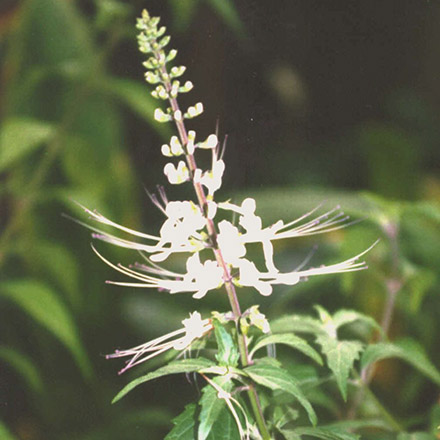Botanical name
Orthosiphon aristatus (Blume) Miq.
Family
Lamiaceae
Common name
Cat's whiskers, Java tea, Kidney tea plant
Information about the plant
Java tea is native to the tropical regions of Asia and is widespread in the eastern parts of the Indian subcontinent, mainland Southeast Asia, and Indonesia. It is also cultivated in Java and Sumatra. The plant owes its name to the four strikingly long stamens, which protrude like a cat's whiskers, as long as a pen, from the lip of the white to pale purple flowers.
The flowers are arranged in spike-like, flowery whorls, which is reflected in the species epithet: Latin “aristatus” (= with spikes). The genus name Orthosiphon comes from the Greek and means "upright tube." The perennial, herbaceous plant grows up to 60 cm and has purple, four-sided stems with coarsely toothed, pointed leaves arranged in decussate pairs.
Medicinally used parts of plants (herbal drug)
The dried leaves and twigs are used. The drug is imported from Indonesia. It is also commercially available as "Kidney tea plant" or "Java tea".
Constituents of the herbal drug
Orthosiphon leaves contain caffeic acid derivatives (including rosmarinic acid), lipophilic flavonoids (including sinensetin), and oxygenated diterpenes (including orthosiphol and orthosiphon).
Quality of the drug
The quality of Orthosiphon leaves (Orthosiphonis folium) is specified in the European Pharmacopoeia (Ph. Eur.).
Medical applications
Recognised medical use
The HMPC has classified Orthosiphon leaves as a traditional herbal medicinal product (see ‘Traditional use’).
ESCOP: To irrigate the urinary tract, especially in cases of inflammation and kidney gravel, and as an adjuvant in bacterial infections of the urinary tract. These indications are based on human experience and long-standing use.
Traditional use
Orthosiphon leaves have been classified by the HMPC as a traditional herbal medicinal product (Article 16a of Directive 2001/83/EC). Based upon long-standing use, Java tea can be used to increase the amount of urine in order to flush the urinary tract as an adjuvant in minor urinary tract complaints.
Herbal drug preparations in finished dosage forms
- Cut Orthosiphon leaves for tea preparation
- Dried extracts in tablets, capsules, and instant teas
Dosage
Prepared drug: See patient information leaflet.
Tea: Drink a cup of Java tea 2 to 4 times a day; average daily dose of 8 to 12 grams of the drug. It is advisable to combine with other drugs such as restharrow, goldenrod, birch leaves, and nettle leaves (bladder and kidney, diuretic tea).
Preparation of a tea
Pour 150ml of boiling water over 2 to 3 g finely chopped Orthosiphon leaves and strain after 10 to 15 minutes.
Notes
Plenty of fluids must be consumed during flushing therapy! A flushing therapy with Orthosiphon leaves must not be performed in the presence of edema due to impaired heart and kidney function. If fever, urinary retention, cramps during urination, or blood in urine occur during treatment, seek medical advice.
There are no studies on the safety of ingesting Orthosiphon leaves during pregnancy and lactation, or in children and adolescents under 18 years of age.
Side effects
None known.
Interactions
None known.
References
Herbal drug monographs
Further literature
Commentary on the European Pharmacopoeia (Orthosiphon leaves, No. 1229).


